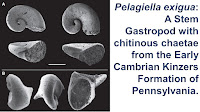Scaphopods, or Tusk Shells, are a distinct group of Molluscs found exclusively living infaunally (i.e. beneath sediments) in marine environments, although they are found in all oceans from the shallow continental shelves to the deepest abyssal environments. Scaphopods have an elongate, tapering shell, between 0.5 and 18 cm in length, curved, but never coiled, with an opening at each end. The body of the Scaphopod is entirely contained within this shell, although it's foot can be extended from the larger opening, to drag the Animal through the sediment. Water is drawn in through the smaller opening, and passed over the mantle of the Scaphopod using cilia, with oxygen being absorbed across the mantle surface (there are no discrete gills). Food particles are extracted from the sediment by a series of tentacles surrounding the foot, and then carried to the mouth. Phylogenetic reconstructions suggest that the Scaphopods were one of the earliest-branching Mollusc groups, but their fossil record only goes back to the Early Carboniferous, making them the youngest class within the Mollusca. This could imply that earlier Scaphopod fossils simply haven't been found, or possibly that early ancestors of Scaphopods lacked shells, subsequently evolving these separately from other Molluscs.
In a paper published in the journal Marine Biology on 7 November 2024, Katrin Linse of the British Antarctic Survey and Jenny Neuhaus of the German Centre for Marine Biodiversity Research describe a new species of deepwater Anemone-associated Scaphopod from the Labrador Sea.
The Labrador Sea separates the northeast coast of Newfoundland from Greenland, and is an area of noted biodiversity, with an ecosystem driven by the admixture of warm waters from the Atlantic with cold waters from the Arctic. The presence of sea ice makes the Labrador Sea the least saline basin of the Atlantic Ocean, with this currently increasing due to the higher rate at which the sea ice is melting, something which impacts on both blooms of Phytoplankton and benthic organisms, and which has the potential to alter the mixing of the deep ocean currents which drive Atlantic circulation. The Labrador Sea can be divided into three bathymetric zones, a wide continental shelf on its southwestern side, the deep Labrador Basin in the centre, and a narrow, steep continental shelf on its northeastern side.
The new Scaphopod species is described on the basis of material collected by trawls of the Labrador Basin at depths of between 3380 and 3390 m, as well as observations of the seabed by remote operated vehicle. The new species is placed in the genus Fissidentalium, and given the specific name aurae, meaning 'breeze', in reference to the windy conditions in the area when the survey was being caried out, as well as to Briese Research, the company which operated the remote operated vehicle used in the research. Genetic analysis confirmed that Fissidentalium aurae is a new species.
Specimens of Fissidentalium aurae are between 15.52 and 63.63 mm in length, and an opaque white in colour, with longitudinal ribs on the shell. Of the 19 Scaphopod specimens collected,18 had an Anemone attached to the upper, convcave, side of their curved shells. Genetic analysis showed these to be members of the genus Maractis, which is otherwise associated with deep-sea hydrothermal vents. Video footage showed the Anemones producing a distinct trail as they were dragged through the sediment by the buried Scaphopods, and actively using their tentacles to acquire food particles from their forward size, reaching over the 'bow wave' of sediment produced by their movement.
See also...










